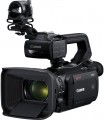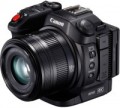Number of megapixels
The total number of individual photosensitive points (pixels) provided in the design of the sensor (1 megapixel corresponds to a million pixels). This parameter takes into account both those points on which the light falls, and service points that are not directly involved in the construction of the image. Therefore, in modern video cameras, it is more of a reference than practically significant; the actual image quality depends primarily on the number of effective megapixels (see below).
Focal length (35mm equivalent)
Focal length of a standard video camera lens in terms of a 35 mm full-frame sensor. This parameter is also called the "equivalent focal length" — EFL.
The focal length itself is the distance from the optical centre of the lens (when focus to infinity) to the sensor, at which the sharpest image is obtained on the sensor. It is one of the key characteristics of any lens, because. determines the viewing angles, the degree of approximation and, accordingly, the specifics of the use of optics. At the same time, it is impossible to compare different options in terms of the actual focal length: the laws of physics are such that with different sizes of sensors, the same focal length will give different viewing angles. Therefore, EFL was adopted as a universal characteristic and criterion for comparison. It can be described as the focal length that a 35mm lens with the same viewing angles would have.
The larger the focal length, the narrower the viewing angle will be and the higher the degree of approximation of the visible scene. Optics with EFL up to 18 mm belongs to the class of ultra wide-angle ("fisheye") and is used primarily to create artistic effects. Distances up to 40 mm correspond to "wide angles", 50 mm gives the same degree of approximation as that of the naked eye, the range of 70-100 mm is considered optimal for portrait shooting, and large values allow the use of optics already as a telephoto lens. Knowing these provisions, one can approximately...evaluate the capabilities of the lens and its suitability for certain tasks; there are more detailed recommendations, they are described in special sources.
Also note that modern video cameras are usually equipped with lenses with a variable focal length (zoom), which allows you to change the degree of approximation and viewing angle; see "Optical Zoom" for details.
Aperture
Aperture of a standard video camera lens.
This parameter describes how much the lens attenuates the light output. Usually it is written as a ratio between the diameter of the active hole and the focal length of the lens, while the first value is taken as one and denoted as f — for example, f/1.8 or f/5.6. Moreover, the smaller the number in such a record, the higher the aperture ratio: for example, in our example, the first option is “lighter” than the second. Also note that most lenses with a variable focal length (see above) also have a variable aperture — in such cases it is indicated by the range from maximum to minimum (from a smaller number to a larger one).
A high aperture ratio is important primarily when shooting in low light conditions: it allows you to capture an image without “lifting up” the sensor sensitivity and without creating additional artifacts in the form of noise, and in the photo shooting mode, you can also work with shorter shutter speeds (which is useful for dynamic scenes). In addition, the higher the aperture, the lower the depth of field and the easier it is to get a blurry background. Note that for simple everyday tasks this parameter does not play a decisive role, but in professional shooting it can be very significant.
Optical zoom
The degree (multiplicity) of image magnification provided by the operation of the lens system in the lens itself, without additional digital processing (see "Digital zoom"). Optical zoom involves changing the focal length (see above): the longer the focal length, the smaller the viewing angle and the larger the objects visible in the frame. And the zoom multiplicity corresponds to the ratio between the maximum and minimum value of this distance. For example, in a 24 – 120 mm system, this parameter will be 120/24 = 5x. However, it is not always appropriate to choose a
high zoom camcorder.
The advantage of optical zoom over digital zoom is, first of all, high image quality: regardless of the degree of zoom, the camera uses the entire effective area of the sensor. At the same time, zoom indicators can reach several tens of times, which is more than enough for camcorders of any class. Therefore, this format is the main one today; it is not used only in some models of pocket cameras (see "Features"), where it is not possible to install a large lens with a zoom lens.
For modern models, the value of this parameter at the level of 10 – 12x is considered standard.
Digital zoom
The degree (multiplicity) of zoom provided by the camcorders due to software methods, without changing the focal length of the optics (see "Optical zoom"). The key principle of such an zoom is that part of the image from the sensor is "stretched" to the entire frame. This somewhat worsens the “picture” — after all, not all effective pixels take part in its formation; and the higher the zoom, the worse the quality becomes. On the other hand, this method does not depend on the specifications of the lens and works even with the simplest lenses that do not have zoom lenses, and it is much easier to achieve high magnification than with the optical method.
In modern camcorders, there are two options for using digital zoom. So, among pocket devices (see "Features"), it may be the only available option — not all of them are equipped with zoom lenses. And in full-size models, digital zoom usually complements optical zoom and turns on after the lens reaches the limit of its capabilities.
Note that when shooting 3D (see above), this feature may not be available, and in professional models it is often not used at all.
Frame frequency
The highest frame rate provided by the camera when shooting video. The minimum frequency for normal viewing is the classic 24 fps used in cinema. At the same time, most modern video cameras are capable of providing up to 50 – 60 fps, and even higher frequencies can be used for the slow motion effect.
In fact, this indicator is important primarily when shooting dynamic scenes. The higher the frame rate, the smoother the fast motion will look in the frame, the less jerky it will be and the more pleasant the overall impression of the image will be. The reverse side of this is an increase in the size of recorded files (all other things being equal). Therefore, the frame rate can be made adjustable so that the operator can choose the best option for a particular situation.
Recording formats
Video file formats that the camera can use to store recorded footage. If you want to view these materials using a separate device (player, media centre, etc.), you should make sure that this player supports the appropriate formats, otherwise conversion may be necessary.
Video recording speed
The data transfer speed provided by the camera when recording video. This parameter is also called bitrate (i.e., the number of bits per unit of time). For any file format used for recording, the general rule is that the higher the bitrate, the better the image quality (especially for formats that use lossy compression). On the other hand, high speed have appropriate requirements for the capabilities of the memory cards used — for more details, see "Memory card support"; and it increases the size of the file accordingly. Therefore, many modern camcorders are able to work with different bitrates; this allows you to choose the best option depending on what is more important for you at the moment — maximum quality or the ability to work with a slow card.
At the same time, we note that in terms of quality, this parameter is important mainly for professional video shooting. If you need a camera for amateur purposes, there is no need to look for the maximum bitrate: after all, such models (and memory cards for them) cost accordingly.
Minimum illuminance
The lowest illumination of the scene being shot, at which the camera is able to provide an image of normal quality. Note that in devices with a night view function (see below), this parameter can be specified in different ways. In some models, minimal illuminance is implied, in which the camera can shoot without backlight and at the same time maintain colour reproduction (as in normal daytime shooting); in others — an "absolute" minimum of light, below which it is impossible to use even the night mode. This point should be clarified according to the official documents of the manufacturer.
Anyway, the lower this indicator, the less light the camera needs to work and the better it handles with shooting at dusk or even at night. Thanks to the use of special technologies, some models are able to work even in complete darkness, with an illumination of 0 lux; this is due to the fact that modern sensors are able to perceive infrared radiation invisible to the eye. However, more often than not, shooting still requires a certain amount of light — at least tenths of a lux. For comparison: an illumination of 0.1 lux approximately corresponds to a lunar night with a “half” phase of the moon, and 1 lux is comparable to a bright full moon in southern latitudes.

